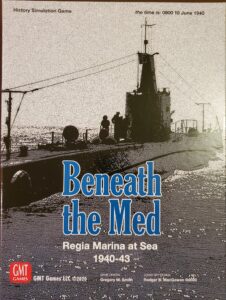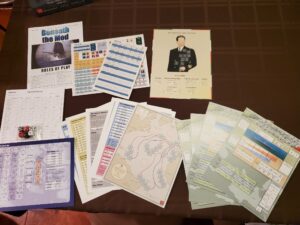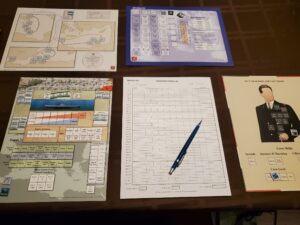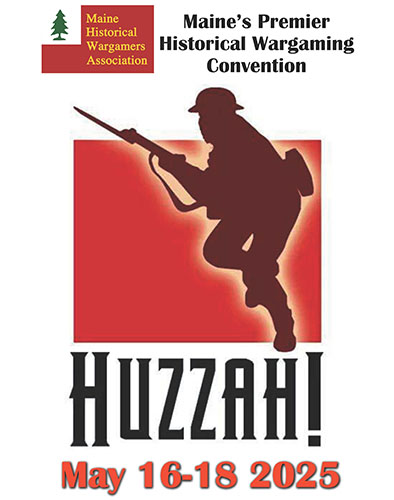Title: Beneath the Med: Regia Marina at Sea 1940-1943
Author: Gregory M. Smith
Publisher: GMT Games
MSRP: $52.00 USD
Period/Setting: World War 2 Italian submarine commander.
Player count: Solo game. There are rules for playing with a second person or in a tournament setting.
Printed Playing time: 2-3 Hours
Overview:
In Beneath the Med you are tasked with leading the Italian submarine of your choice, from June 1940 through August 1943. You pick one of the 12 classes of sub possessed by the Italian Navy and play through your career during the war. Each sub has a display mat that lets you track all the pertinent information you will need for your missions. It also includes some real-life specs and an image of the submarine.
Since this game is designed to be played solo, all the encounters are randomized through die rolls on tables. There are also tables for all the types of ship you could encounter. These tables tell you the tonnage and name the ship encountered. I enjoyed having every ship being named since I found myself looking up details on each warship/ capital ship when I encountered one of them.
This is the fourth game in the series and the only one that is played from the Italian perspective. “The Hunters” with the German U-Boats has two games: one for the early, mid war and one for the late war. “Silent Victory” is for the Americans in the Pacific. If you have played any of those games, then you will be able to quickly grasp the rules. The rules changes are basically tweaks that reflect how the Italian subs handled and fought during the war.
The author did an excellent job putting in historical facts through the rulebook. For example, he explains the differences in the types of torpedoes and the differences in the naming conventions between factories. There are two short biographies of Italian “aces” so you can see how you compare to real world commanders. The bibliography at the end of the rules was a useful addition that I am not used to seeing in rulebooks.
Gameplay:
I found the rules easy to follow and I went to sea after a single reading of the rules.
When starting a game, you need to pick your sub and the corresponding play mat. The playmat keeps track of patrol location, damage, crew, ammo, and torpedoes.
There is a separate sheet for the Comandante (you) and your crew, but it is used to track your medals and rank along with any unlocked special crew abilities. I found that I did not use it during gameplay. I did like seeing the medals getting pinned to my chest when back in port.
Once your sub has been chosen you choose (or roll) your starting port, be advised that not all subs have a choice on where they start. The game offers two locations to start and this determines if you are going to be patrolling in the Atlantic or the Mediterranean.
Once you have your starting location and have loaded your torpedoes you roll on the table corresponding to the year and location of your home port. This roll tells you where you are being sent for your patrol and if you are undergoing any sort of special mission that might alter your initial equipment load out. These special missions can be anything from simple minelaying up to being sent on supply runs to Singapore.
On your patrol, you move your chit from box to box on the track rolling for encounters until you get back to port. Encounters can range from being attacked by aircraft, to encountering a convoy filled with targets, or empty water and not finding anything. When you do have an encounter, you are responsible for the tactical choices in how you handle your attack. You can get in close to have your best chance to hit; but they might see you coming and make you call off your attack; or you can stay at extreme range and be really hard to detect but you had better roll really well if you even want a chance to hit.
All the tables needed on patrols are found on the 5 double-sided player aids. This may sound like lots of space, but 3 sides contain tables for naming your targets. While others are used on certain special missions or determining the patrol you will be sent on. I found that most of the time I kept using 3 sides of the Player Aids, the one for the encounters, the one for repairing damage and the one for engaging in combat. All the player aids are helpful and lay everything out for easy reference.
When you arrive back in port you can tally up the tonnage you sank while your ship is in for repairs. You could also get a promotion or medal based on your career up to that point. Your rank does offer some special bonuses like being able to try and alter your patrol assignment. Medals on the other hand are mostly decorative, but a few allow you to offset some penalties or make you a bit harder to detect. These modifiers are going to be useful and you should make sure you work towards earning them quickly.
Once your ship is repaired you roll again on the corresponding patrol table to figure out your next patrol. The game continues in the Patrol, Repair, Patrol, Repair cycle until August 1943 or you are sunk.
Final Thoughts:
I have enjoyed playing this game and it will come out more, especially since my gaming group has shrunk to only my wife. I have been able to take over a table and I have left the game set up. This lets me play a few patrols a night and not get overwhelmed by what could become an exceedingly long play time.
If you own and like any of the other games in this series, then this will be a welcome addition to your collection.
For those who have not played any of the other games in this series and you like solo narrative tactical games, then this could be worth your time. If you do have preference on U-boats or American submarines, then check out “The Hunters” or “Silent Victory” instead.
Maybe the British Navy has enough submarine warfare to merit a game of its own. Before this game I knew very little of the Italian submarines; perhaps there is much to learn about the British submariners.
Please note I received a copy of the game in exchange for a review.





